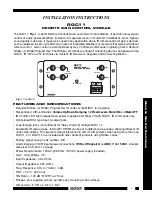
User’s Manual
27
4.2 Sample Programs
The following sample programs are available for the Wi-Fi Add-On Kits, and can be
found in the Dynamic C
Samples\TCPIP\WIFI
folder.
•
WIFI_SCAN.C
—initializes the Wi-Fi card and scans for other Wi-Fi devices that are
operating in either the ad-hoc mode or through access points in the infrastructure mode.
No network parameter settings are needed since the Wi-Fi CompactFlash card does not
actually join an 802.11b network. This program outputs the results of the scan to the
Dynamic C
STDIO
window.
•
WIFI_SCAN_LCD.C
—initializes the Wi-Fi card and scans for other Wi-Fi devices that
are operating in either the ad-hoc mode or through access points in the infrastructure
mode. No network parameter settings are needed since the Wi-Fi CompactFlash card
does not actually join an 802.11b network. This program outputs the results of the scan
to the optional LCD/keypad module that plugs into the Prototyping Board.
•
WPINGME.C
—initializes the TCP/IP stack, sets the Wi-Fi card to the infrastructure
mode or the ad-hoc mode, and sets the network parameters based on the
TCPCONFIG
macro from the
TCP_CONFIG.LIB
library. The RabbitCore or PowerCore module can
then be pinged from another device.
•
DYNAMIC_WIFI.C
—initializes the Wi-Fi CompactFlash card and scans for other Wi-Fi
devices that are operating in either the ad-hoc mode or through access points in the
infrastructure mode. You will then be able to select which Wi-Fi device/network to
connect to.
•
DATALOGGER.C
—logs users who request a Web page via a browser and logs key-
presses for switch S2 on the Prototyping Board (switch S1 on the RCM3600/3700
Prototyping Board). The log can be viewed online.
•
WIFISERIAL.C
—allows networked clients to initiate a connection to a TCP/IP socket
to communicate with one of the asynchronous serial ports on a Prototyping Board.
•
WIFI_ETHERNET_COMBO.C
—demonstrates how to use the Wi-Fi and wired Ethernet
interfaces simultaneously. The sample program shows how to listen for connections on
two sockets on two IP addresses specified in the sample program. A Telnet connection
to either IP address will echo back each line of typed text.
Each sample program has comments that describe the purpose and function of the pro-
gram. Follow the instructions at the beginning of the sample program.
4.2.1 What Else You Will Need
Besides what is supplied with the Wi-Fi Add-On Kits, you will need a PC with an available
COM or USB port to program the RabbitCore or PowerCore module. You will need either
an access point for an existing Wi-Fi network that you are allowed to access and have a PC
or notebook connected to that network (infrastructure mode), or you will need at least a
PDA or PC with a Wi-Fi CompactFlash card to use the ad-hoc mode. If your PC only has
a USB port, you will also need an RS-232/USB converter (Z-World Part No. 540-0070).
You will also need an LCD/keypad module if you wish to run the
WIFI_SCAN_LCD.C
sample program.
Summary of Contents for RCM3000
Page 8: ...4 802 11b Wi Fi Add On Kits ...
Page 28: ...24 802 11b Wi Fi Add On Kits ...
Page 56: ...52 802 11b Wi Fi Add On Kits ...
Page 60: ...56 802 11b Wi Fi Add On Kits ...
Page 68: ...64 802 11b Wi Fi Add On Kits ...
Page 78: ...74 802 11b Wi Fi Add On Kits ...
Page 80: ...76 802 11b Wi Fi Add On Kits ...
Page 82: ...78 RabbitCore RCM3800 ...
Page 86: ......
















































